Machine Learning-Based Prediction of Selected Parameters of Commercial Biomass Pellets Using Line Scan Near Infrared-Hyperspectral Image
Abstract
1. Introduction
2. Materials and Methods
2.1. Investigated Parameters
2.2. Sample
2.3. NIR Hyperspectral Image Measurement
2.4. Reference Methods
2.5. Model Development and Validation
2.6. Visualisation of FR, VM, FC, and A in the Distribution Map
3. Results and Discussion
3.1. NIR Spectra
3.2. Reference Value
3.3. Result of Model Development
3.4. Result Visualisation of FR, VM, FC, and A in the Distribution Map
4. Conclusions
Author Contributions
Funding
Institutional Review Board Statement
Informed Consent Statement
Data Availability Statement
Acknowledgments
Conflicts of Interest
References
- International Renewable Energy Agency. Renewable Energy Outlook: Thailand; International Renewable Energy Agency: Abu Dhabi, United Arab Emirates, 2017; ISBN 978-92-9260-035-8. [Google Scholar]
- Renewable Energy Industry Club. The Direction of Energy. 2020. Available online: https://www.re-fti.org/Direction-energy-2563/ (accessed on 17 May 2020).
- Olaoye, J.O. Biomass as Sustainable Sources of Renewable Energy. 2014. Available online: https://www.researchgate.net/publication/298353780 (accessed on 17 May 2020).
- Yokoyama, S. Guidelines and Use Biomass for the Production; Support Program for Building of Asia Alliances for Agriculture and Environmental; Ministry of Agriculture, The Japan Institute of Energy: Tokyo, Japan, 2008; pp. 1–270.
- Biomass Resources. Available online: https://www.energy.gov/eere/bioenergy/biomass-resources (accessed on 10 January 2021).
- National Geographic Asia. Renewable Energy. Available online: https://ngthai.com/science/26556/renewable-energy/. (accessed on 17 May 2020).
- Ministry of Science and Technology. Wood Pellets. Available online: https://www.mhesi.go.th/knowledge/wood-pellets. (accessed on 17 May 2020).
- Department of Alternative Energy Development and Efficiency. Study Project of Biomass Pellet Standard for Development as a Biomass Fuel in the Future; Final Report; Faculty of Engineering and Industrial Technology Silpakorn University: Nakhon Pathom, Thailand, 2012; pp. 1–272. [Google Scholar]
- iEnergyGuru. Properties of Biomass Sources. Available online: https://ienergyguru.com/properties-of-biomass-sources/ (accessed on 17 May 2020).
- Garcia, R.; Pizarro, C.; Lavin, A.G. Spanish biofuels heating value estimation. Part I Ultimate analysis data. J. Fuel 2014, 117, 1130–1138. [Google Scholar] [CrossRef]
- Sudarmanta, B. Dual fuel engine performance using biodiesel and syn-gas from rice husk downdraft gasification for power generation. Semin. Int. Biomass 2015. [Google Scholar] [CrossRef]
- Sethi, P.; Mohapatro, R.N.; Mohanty, R.S.; Seet, S.K.; Nagarajan, R.; Roy, G.G. Study on spontaneous combustion of boiler grade coal and optimization of consumption at RinI. IOP Conf. Ser. Mater. Sci. Eng. 2018, 455, 12–86. [Google Scholar] [CrossRef]
- Feng, X.; Yu, C.; Shu, Z.; Liu, X.; Yan, W.; Zheng, Q.; Sheng, K.; He, Y. Rapid and nondestructive measurement of biofuel pellet quality indices based on two-dimensional near infrared spectroscopic imaging. J. Fuel 2018, 228, 197–205. [Google Scholar] [CrossRef]
- Posom, J.; Saechua, W.; Sirisomboon, P. Evaluation of pyrolysis characteristics of milled bamboo using near-infrared spectroscopy. Renew. Energy 2017, 103, 653–665. [Google Scholar] [CrossRef]
- Xue, J.; Yang, Z.; Han, L.; Liu, Y.; Liu, Y.; Zhou, C. On-line measurement of proximates and lignocellulose components of corn stover using NIRS. J. Applied. Energy 2015, 137, 18–25. [Google Scholar] [CrossRef]
- Fagan, C.C.; Everard, C.D.; Mcdonnell, K.P. Prediction of moisture, calorific value, ash and carbon content of two dedicated bioenergy crops using near-infrared spectroscopy. Bioresour. Technol. 2011, 102, 5200–5206. [Google Scholar] [CrossRef] [PubMed]
- Gillespie, G.D.; Everard, C.D.; Mcdonnell, K.P. Prediction of biomass pellet quality indices using near infrared spectroscopy. J. Energy 2015, 80, 582–588. [Google Scholar] [CrossRef]
- Pitak, L.; Sirisomboon, P.; Saengprachatanarug, K.; Wongpichet, S.; Posom, J. Rapid elemental composition measurement of commercial pellets using line-scan hyperspectral imaging analysis. Energy 2021, 220, 119698. [Google Scholar] [CrossRef]
- Shaw, R.A.; Kotowich, S.; Mantsch, H.H.; Leroux, M. Quantitation of protein, creatinine, and urea in urine by near-infrared spectroscopy. Clin. Biochem. 1996, 29, 11–19. [Google Scholar] [CrossRef]
- Gillespie, G.D.; Gowen, A.A.; Finnan, J.M.; Carroll, J.P.; Farrelly, D.J.; Mcdonnell, K.P. Near infrared hyperspectral imaging for the prediction of gaseous and particulate matter emissions from pine wood pellets. J. Biosyst. Eng. 2019, 179, 94–105. [Google Scholar] [CrossRef]
- Gillespie, G.D.; Farrelly, D.J.; Everard, C.D.; Mcdonnell, K.P. The use of near infrared hyperspectral imaging for the prediction of processing parameters associated with the pelleting of biomass feedstocks. J. Fuel Process. Technol. 2016, 152, 343–349. [Google Scholar] [CrossRef]
- Geoffrey, P.L.; Nam, S.Y.; Stanislav, Y.E. Optical wavelength selection for improved spectroscopic photoacoustic imaging. Photoacoustics 2013, 1, 36–42. [Google Scholar]
- Posom, J.; Klaprachan, J.; Rattanasopa, K.; Sirisomboon, P.; Saengprachatanarug, K.; Wongpichet, S. Predicting Marian Plum Fruit Quality without Environmental Condition Impact by Handheld Visible–Near-Infrared Spectroscopy. J. ACS Omega 2020, 5, 27909–27921. [Google Scholar] [CrossRef] [PubMed]
- Su, W.H.; Sun, D.W. Comparative assessment of feature-wavelength eligibility for measurement of water binding capacity and specific gravity of tuber using diverse spectral indices stemmed from hyperspectral images. Comput. J. Electron. Agric. 2016, 130, 69–82. [Google Scholar] [CrossRef]
- Su, W.H. Advanced Machine Learning in Point Spectroscopy, RGB- and Hyperspectral-Imaging for Automatic Discriminations of Crops and Weeds: A Review. Smart Cities 2020, 3, 39. [Google Scholar] [CrossRef]
- Chadwick, D.T.; Mcdonnell, K.P.; Brennan, L.P.; Fagan, C.C.; Everard, C.D. Evaluation of infrared techniques for the assessment of biomass and biofuel quality parameters and conversion technology processes: A review. J. Renew. Sustain. Energy Rev. 2014, 30, 672–681. [Google Scholar] [CrossRef]
- Dardenne, P. Some considerations about NIR spectroscopy. Closing speech at NIR-2009. NIR News 21 2010, 8–14. [Google Scholar] [CrossRef]
- Liu, D.; Sun, D.W.; Zeng, X.A. Recent advances in wavelength selection Techniques for hyperspectral image processing in the food industry. J. Food Bioprocess Technol. 2014, 7, 307–323. [Google Scholar] [CrossRef]
- Patel, M. Principal Component Analysis (PCA): An Unsupervised Learning. 2016. Available online: https://rpubs.com/maulikpatel/231900 (accessed on 17 May 2020).
- Araujo, M.C.U.; Saldanha, T.C.B.; Galvão, R.K.H.; Yoneyama, T.; Chame, H.C.; Visani, V. The successive projections algorithm for variable selection in spectroscopic multicomponent analysis. Chemometr. Intell. Lab. Syst. 2001, 57, 65–73. [Google Scholar] [CrossRef]
- Fei, L.; Yong, H. Application of successive projections algorithm for variable selection to determine organic acids of plum vinegar. J. Food Chem. 2009, 115, 1430–1436. [Google Scholar]
- Romìa, M.B.; Bernàrdez, M.A. Infrared Spectroscopy for Food Quality Analysis and Control; Academic Press: San Francisco, CA, USA, 2009; pp. 74–75. [Google Scholar]
- Ghasemi, J.; Niazi, A.; Leardi, R. Genetic-algorithm-based wavelength selection in multicomponent spectrophotometric determination by PLS: Application on copper and zinc mixture. Talanta 2003, 59, 311–317. [Google Scholar] [CrossRef]
- Ferraro, M.C.; Castellano, P.M.; Kaufman, T.S. A spectrophotometric-partial least squares (PLS-1) method for the simultaneous determination of furosemide and amiloride hydrochloride in pharmaceutical formulations. J. Pharm. Biomed. Anal. 2001, 26, 443–451. [Google Scholar] [CrossRef]
- Nicolai, B.M.; Beullens, K.; Bobelyn, E.; Peirs, A.; Saeys, W.; Theron, K.I.; Lammertyn, J. Nondestructive measurement of fruit and vegetable quality by means of NIR spectroscopy: A review. Postharvest Biol. Technol. 2007, 46, 99–118. [Google Scholar] [CrossRef]
- Zornoza, R.; Guerrero, C.; Mataix-Solera, J.; Scow, K.M.; Arcenegui, V.; Mataix-Beneyto, J. Near infrared spectroscopy for determination of various physical, chemical and biochemical properties in Mediterranean soils, Soil Biol. J. Biochem. 2008, 40, 1923–1930. [Google Scholar]
- García Martín, J.F. Optical path length and wavelength selection using Vis/NIR spectroscopy for olive oil’s free acidity determination. Int. J. Food Sci. Technol. 2015, 50, 1461–1467. [Google Scholar] [CrossRef]
- Osborne, B.G.; Fearn, T. Near Infrared Spectroscopy in Food Analysis; Longman Science & Technical: London, UK, 1986; pp. 36–40. [Google Scholar]
- Yang, Z.; Li, K.; Zhang, M.; Xin, D.; Zhang, J. Rapid determination of chemical composition and classification of bamboo fractions using visible near infrared spectroscopy coupled with multivariate data analysis. J. Biotechnol. Biofuels 2016, 9, 35. [Google Scholar] [CrossRef] [PubMed]
- Posom, J.; Sirisomboon, P. Evaluation of the higher heating value, volatile matter, fixed carbon and ash content of ground bamboo using near infrared spectroscopy. J. Near Infrared Spectrosc. 2017, 25, 301–310. [Google Scholar] [CrossRef]
- Galvao, R.K.; Araujo, M.C.; Jose, G.E.; Pontes, M.J.; Silva, E.C.; Saldanha, T.C. A method for calibration and validation subset partitioning. Talanta 2005, 67, 736–740. [Google Scholar] [CrossRef] [PubMed]
- Posom, J.; Sirisomboon, P. Evaluation of lower heating value and elemental composition of bamboo using near infrared spectroscopy. J. Energy 2017, 121, 147–158. [Google Scholar] [CrossRef]
- Sirisomboon, P.; Funke, A.; Posom, J. Improvement of proximate data and calorific value assessment of bamboo through near infrared wood chips acquisition. J. Renew. Energy 2020, 147, 1921–1931. [Google Scholar] [CrossRef]

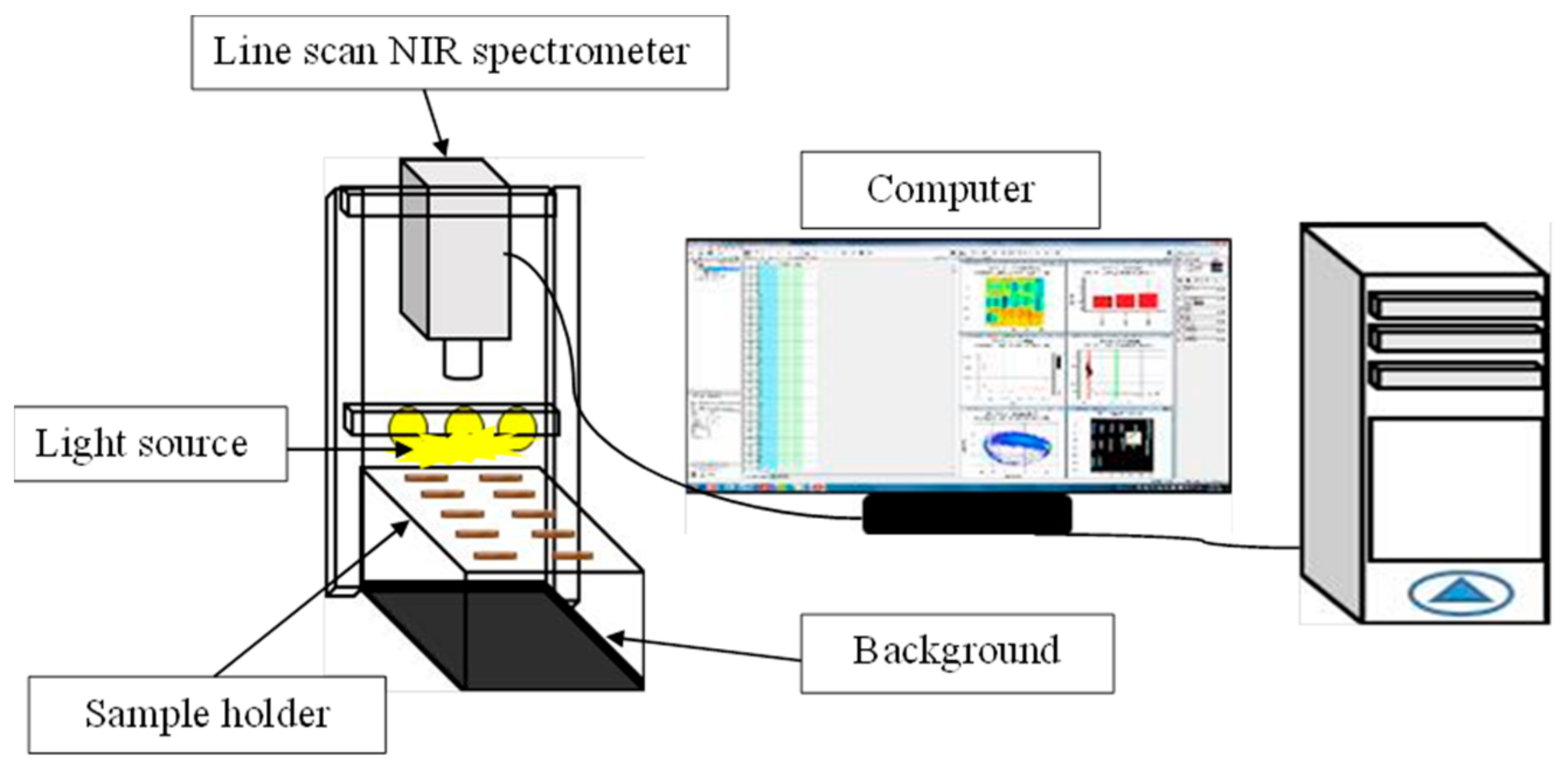
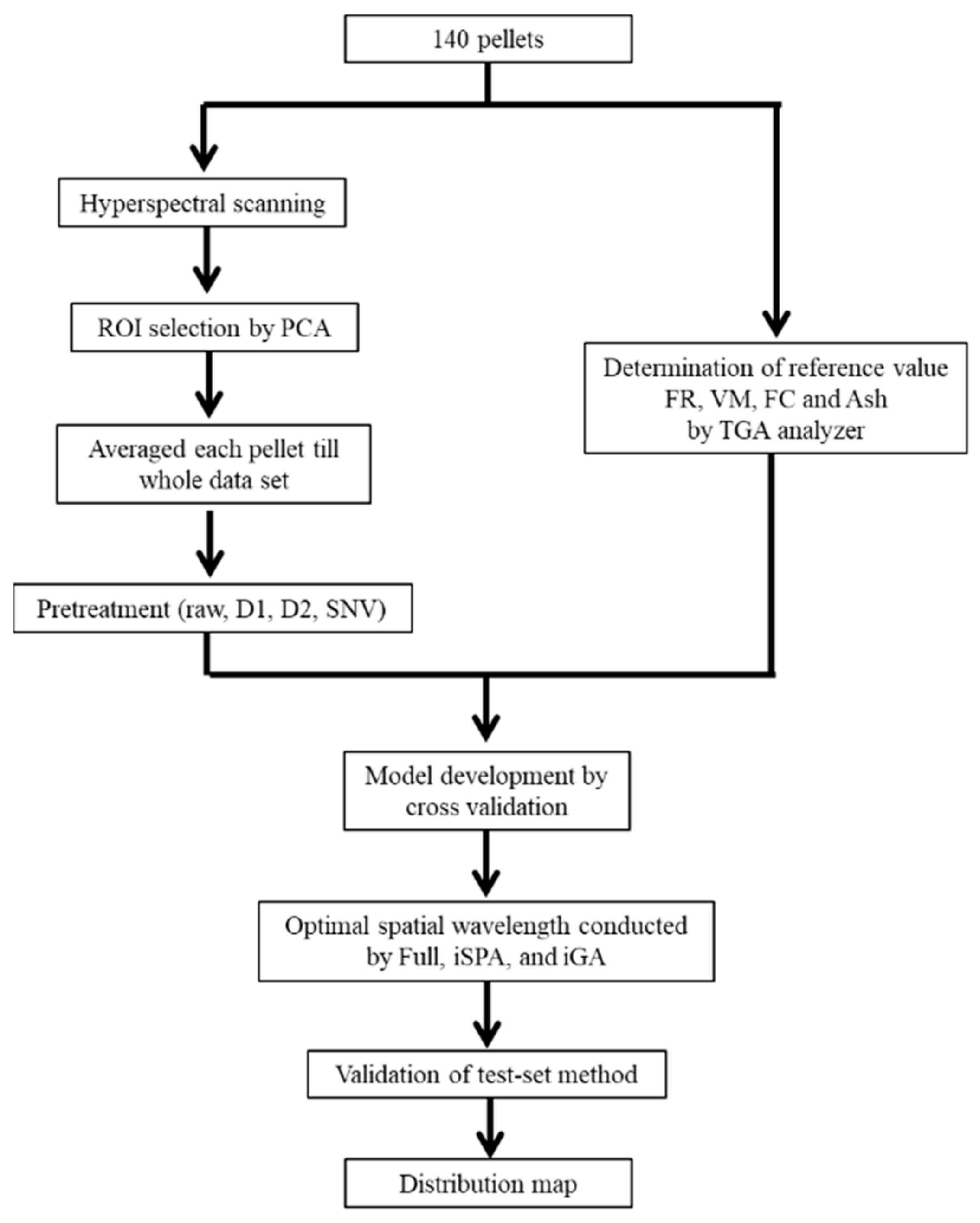
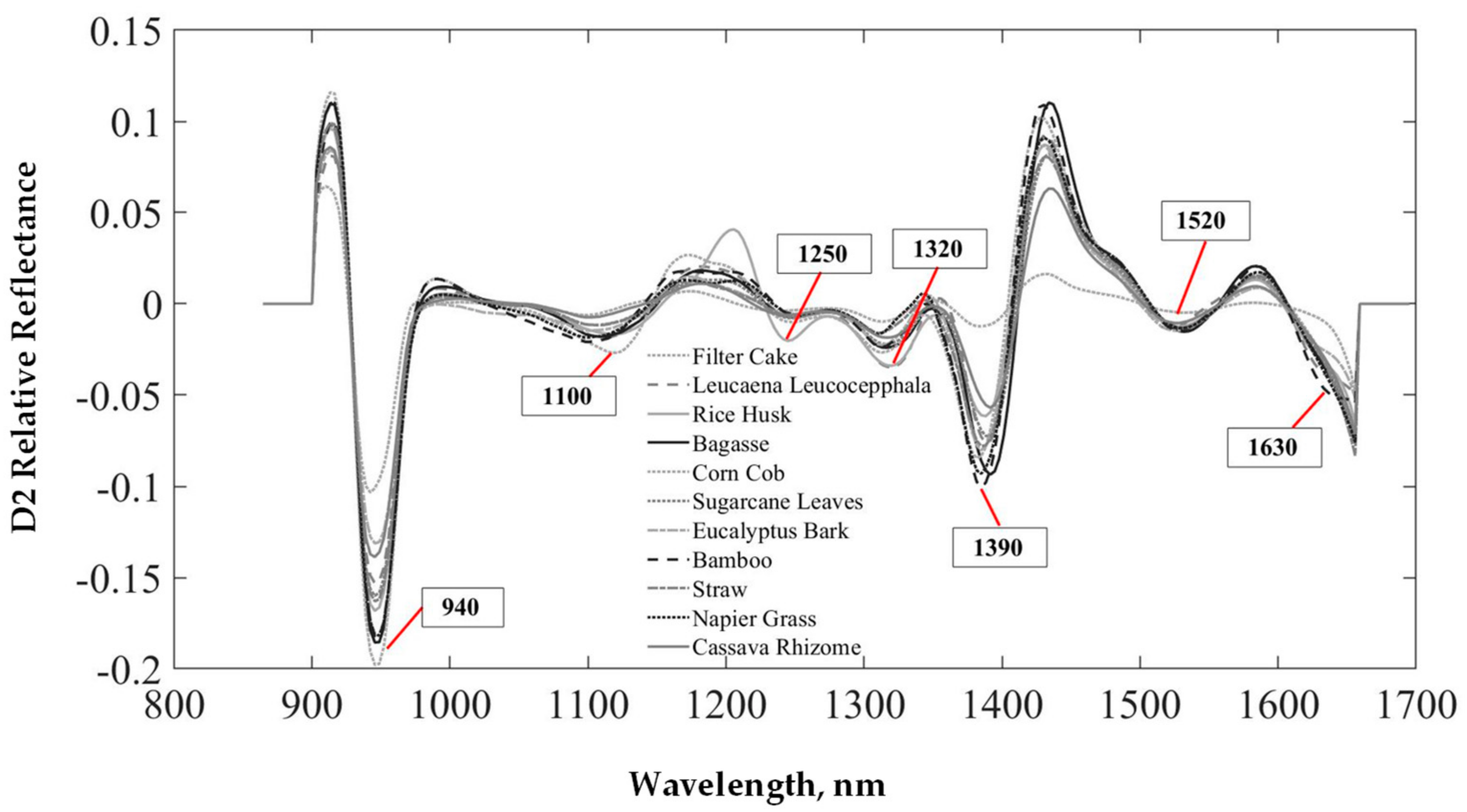
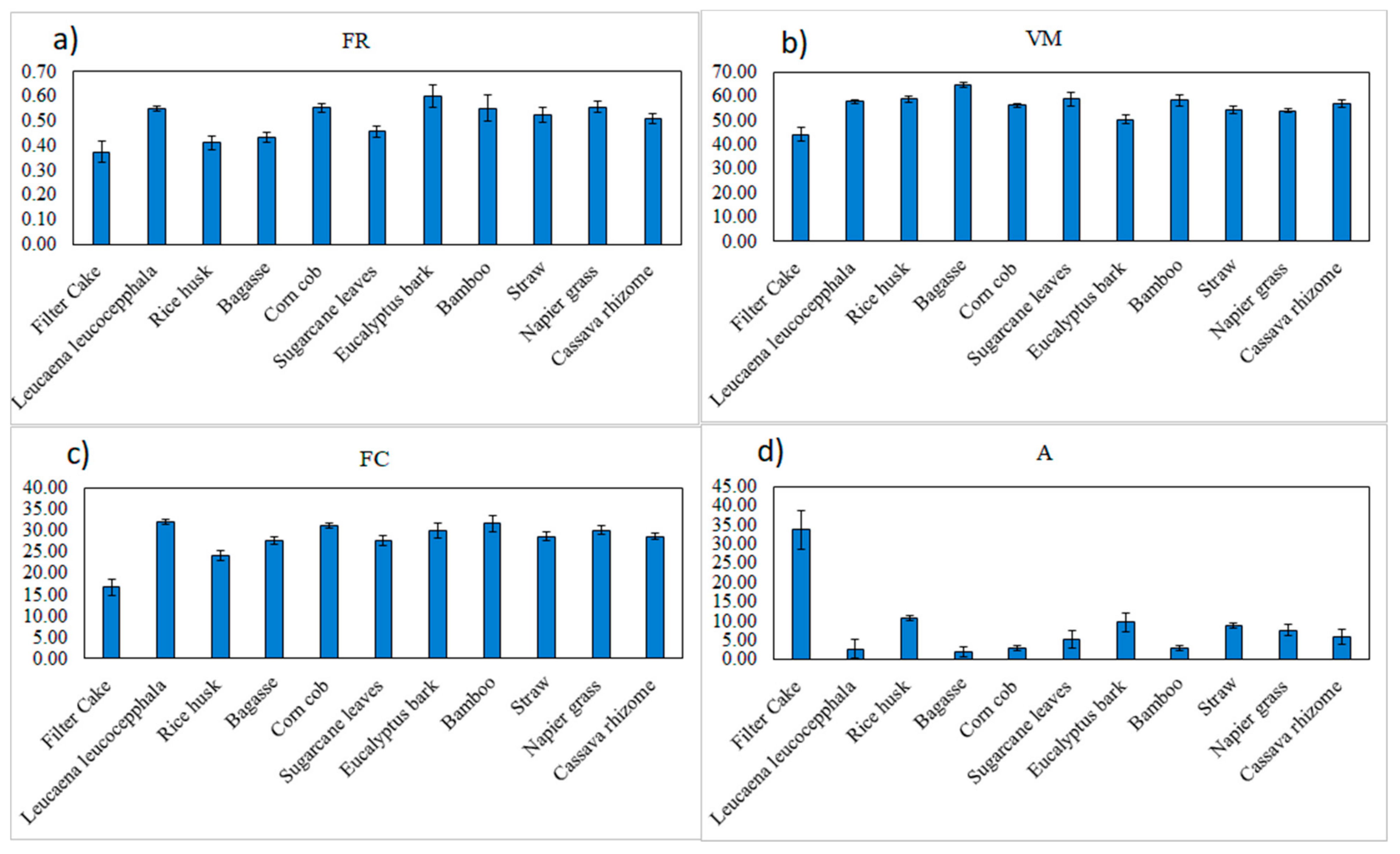


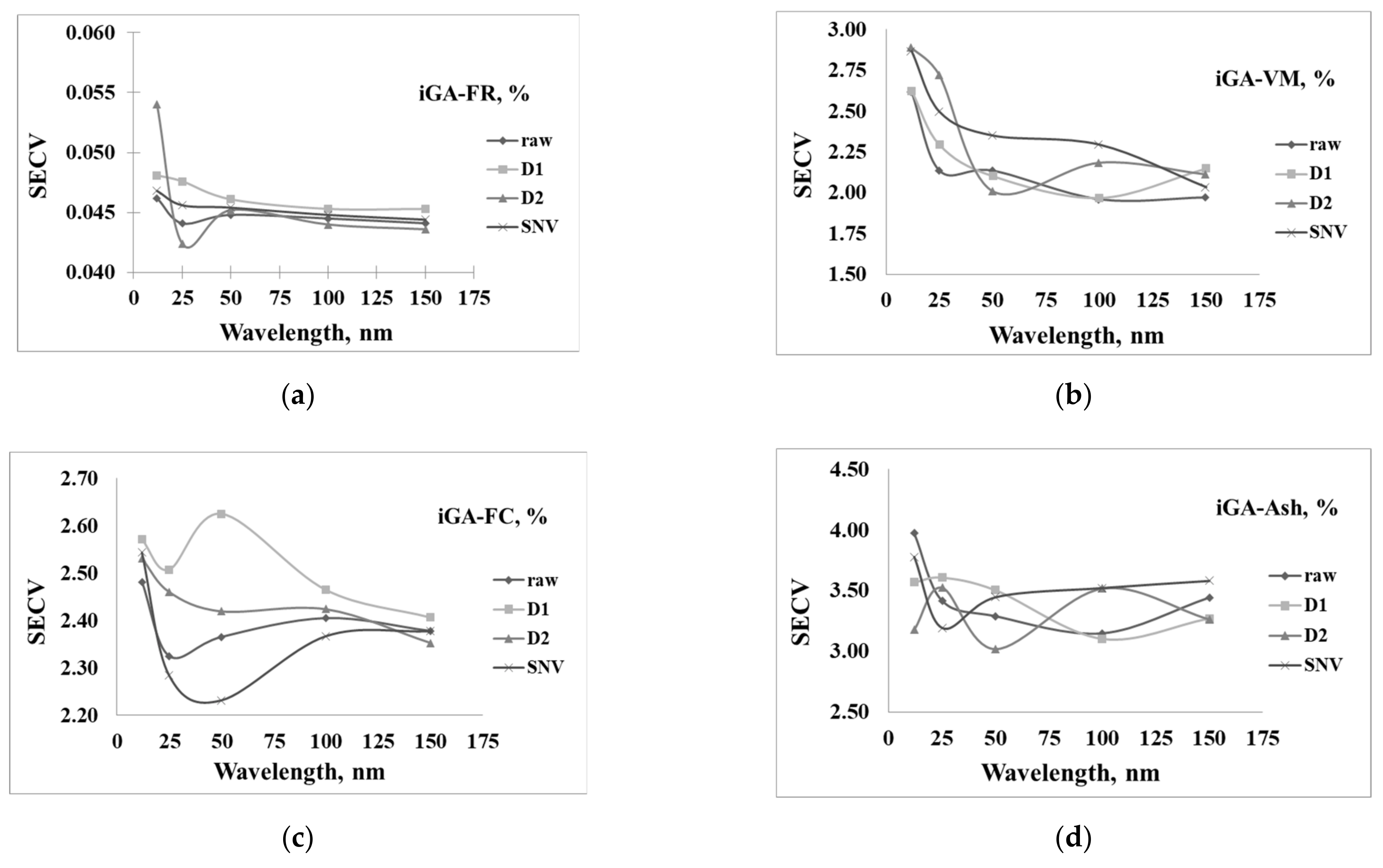
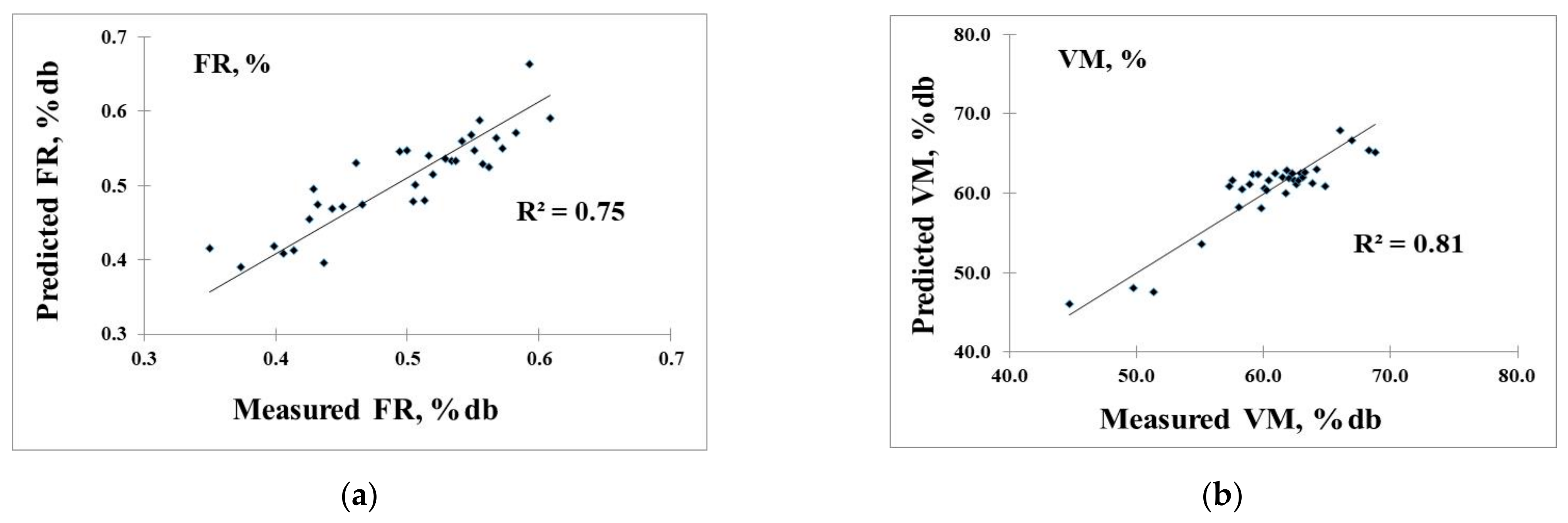

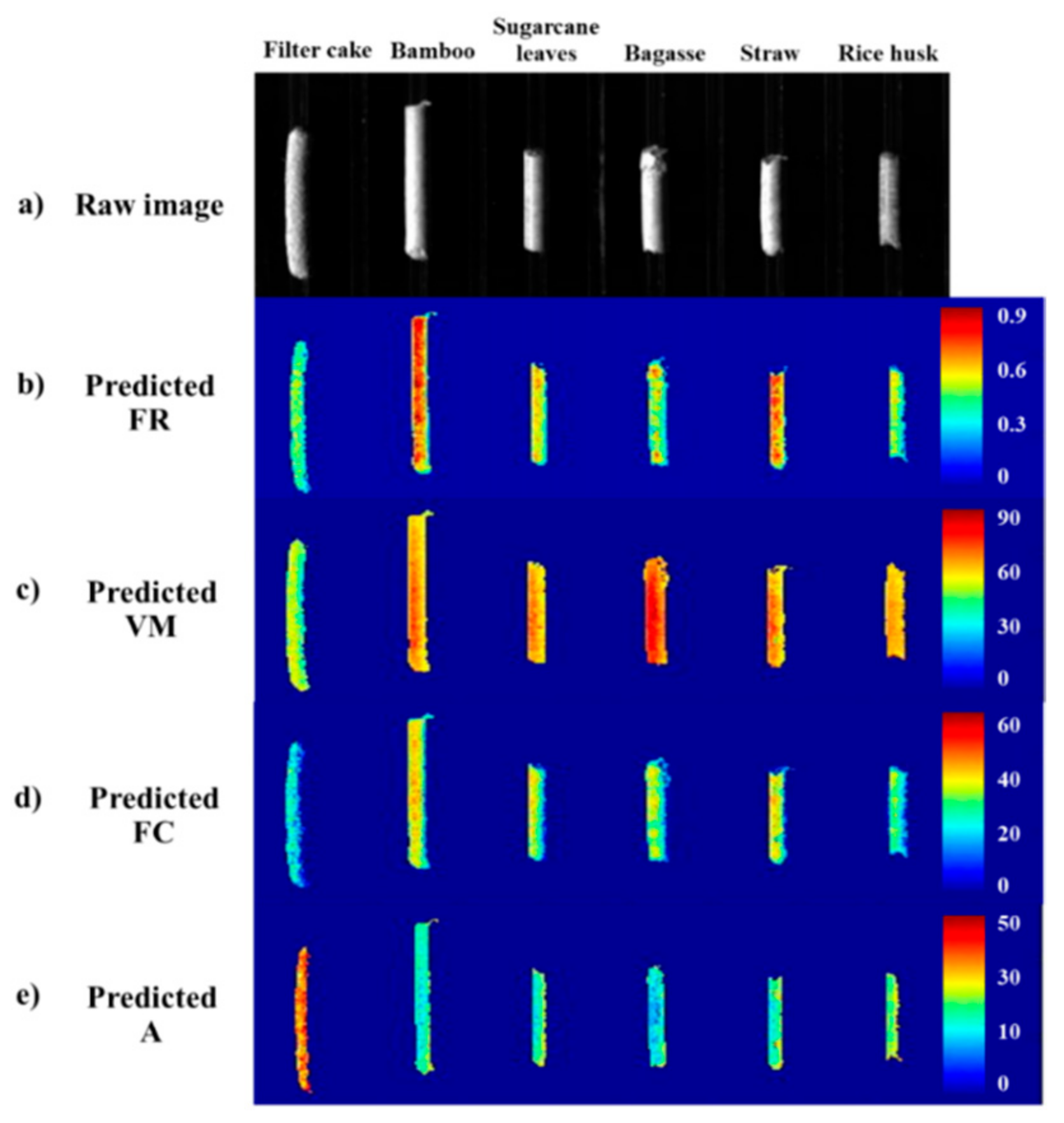
| Parameters | N | Max | Min | Mean | Range | SD |
|---|---|---|---|---|---|---|
| FR, db% | 140 | 0.68 | 0.30 | 0.51 | 0.38 | 0.07 |
| VM, db% | 140 | 66.77 | 39.20 | 56.71 | 27.57 | 5.17 |
| FC, db% | 140 | 35.23 | 12.83 | 28.89 | 22.40 | 4.17 |
| A, db% | 140 | 41.57 | 1.40 | 7.42 | 40.17 | 8.01 |
| Parameter | SEL | R2max |
|---|---|---|
| FR, % | 0.01 | 0.98 |
| VM, % | 0.65 | 0.99 |
| FC, % | 0.33 | 0.99 |
| Ash, % | 1.02 | 0.98 |
| Parameters | N | Method | Wavelength | Pretreatment | lv | R2cal | R2val | SEC | SECV |
|---|---|---|---|---|---|---|---|---|---|
| FR, % | 140 | Full-PLS | 256 | raw | 8 | 0.71 | 0.63 | 0.04 | 0.04 |
| 140 | iSPA-PLS | 100 | D2 | 9 | 0.78 | 0.72 | 0.03 | 0.04 | |
| 140 | iGA-PLS | 25 | D2 | 10 | 0.72 | 0.66 | 0.04 | 0.04 | |
| VM, % | 140 | Full-PLS | 256 | D1 | 8 | 0.89 | 0.86 | 1.74 | 1.95 |
| 140 | iSPA-PLS | 100 | SNV | 8 | 0.90 | 0.88 | 1.67 | 1.85 | |
| 140 | iGA-PLS | 100 | raw | 9 | 0.89 | 0.86 | 1.75 | 1.96 | |
| FC, % | 140 | Full-PLS | 256 | SNV | 9 | 0.88 | 0.85 | 1.59 | 1.82 |
| 140 | iSPA-PLS | 100 | SNV | 8 | 0.85 | 0.81 | 1.78 | 2.01 | |
| 140 | iGA-PLS | 50 | SNV | 10 | 0.83 | 0.77 | 1.91 | 2.23 | |
| Ash, % | 140 | Full-PLS | 256 | SNV | 9 | 0.93 | 0.91 | 2.18 | 2.48 |
| 140 | iSPA-PLS | 100 | SNV | 7 | 0.92 | 0.91 | 2.36 | 2.62 | |
| 140 | iGA-PLS | 50 | D2 | 9 | 0.90 | 0.87 | 2.69 | 3.02 |
| Parameters | Calibration Set | Validation Set | |||||||
|---|---|---|---|---|---|---|---|---|---|
| PLS Factor | N | R2 | SEC | n | r2 | SEP | RPD | Bias | |
| FR, % | 9 | 106 | 0.76 | 0.04 | 34 | 0.75 | 0.03 | 1.97 | 0.01 |
| VM, % | 8 | 106 | 0.91 | 1.62 | 34 | 0.82 | 2.10 | 2.46 | 0.10 |
| FC, % | 8 | 106 | 0.86 | 1.82 | 34 | 0.81 | 1.80 | 2.32 | −0.39 |
| Ash, % | 7 | 106 | 0.93 | 2.27 | 34 | 0.88 | 2.53 | 3.17 | −0.44 |
Publisher’s Note: MDPI stays neutral with regard to jurisdictional claims in published maps and institutional affiliations. |
© 2021 by the authors. Licensee MDPI, Basel, Switzerland. This article is an open access article distributed under the terms and conditions of the Creative Commons Attribution (CC BY) license (http://creativecommons.org/licenses/by/4.0/).
Share and Cite
Pitak, L.; Laloon, K.; Wongpichet, S.; Sirisomboon, P.; Posom, J. Machine Learning-Based Prediction of Selected Parameters of Commercial Biomass Pellets Using Line Scan Near Infrared-Hyperspectral Image. Processes 2021, 9, 316. https://doi.org/10.3390/pr9020316
Pitak L, Laloon K, Wongpichet S, Sirisomboon P, Posom J. Machine Learning-Based Prediction of Selected Parameters of Commercial Biomass Pellets Using Line Scan Near Infrared-Hyperspectral Image. Processes. 2021; 9(2):316. https://doi.org/10.3390/pr9020316
Chicago/Turabian StylePitak, Lakkana, Kittipong Laloon, Seree Wongpichet, Panmanas Sirisomboon, and Jetsada Posom. 2021. "Machine Learning-Based Prediction of Selected Parameters of Commercial Biomass Pellets Using Line Scan Near Infrared-Hyperspectral Image" Processes 9, no. 2: 316. https://doi.org/10.3390/pr9020316
APA StylePitak, L., Laloon, K., Wongpichet, S., Sirisomboon, P., & Posom, J. (2021). Machine Learning-Based Prediction of Selected Parameters of Commercial Biomass Pellets Using Line Scan Near Infrared-Hyperspectral Image. Processes, 9(2), 316. https://doi.org/10.3390/pr9020316







